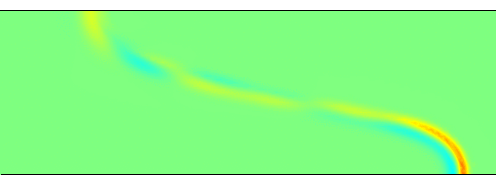Linear Stability Analysis of Gas Turbine Combustion Chambers
by Max Meindl and Wolfgang Polifke
Motivation
Thermoacoustic instabilities are a limiting factor in development and operation of gas turbines used for power generation and propulsion. This problem arose when lean premixed combustion was employed due to emission restrictions of pollutants (mainly NOx and CO). The flames in the combustion chamber of the gas turbine are influenced by acoustic waves. This results in unsteady heat release and may lead to increased material wear or even fatal damage of high pressure turbine and combustion chamber components.
Objectives

The prediction of thermoacoustic instabilities in the design phase is a crucial task for the development of a stable operating gas turbine. While high fidelity Large Eddy Simulations of the whole combustion chamber are too expensive, affordable low-order models (e.g. quasi-1D thermoacoustic network models) do not account for the complex geometry and 3D effects. An affordable approach to investigate linear stability are linear acoustic governing equations (e.g. linearized Navier-Stokes equations), discretized by the Finite Element Method (FEM). Based on these linear, spatially resolved models, the thermoacoustic eigenmodes and the frequency response can be computed to assess stability while the computational cost for this method remains within affordable limits.
Methodology
The research in this project focuses on the development of linear thermoacoustic models based on the Discontinuous Galerkin Finite Element Method (DG-FEM) in a state-space interconnect framework [1,2]. The unsteady heat release of the flame is taken into account either via the well known concept of a Flame Transfer Function [3] or the newly developed approach of linearizing the reaction kinetics and species transport equations [4]. The latter is known as the monolithic linearized reactive flow (LRF) and yields increased accuracy in the prediction of thermoacoustic instabilities [5].

Selected Publications
[1] T. Emmert, M. Meindl, S. Jaensch, and W. Polifke. “Linear State Space Interconnect Modeling of Acoustic Systems.” Acta Acustica United with Acustica 102, no. 5 (2016): 824–33. https://doi.org/10.3813/AAA.918997.
[2] M. Meindl, T. Emmert, and W. Polifke. “Efficient Calculation of Thermoacoustic Modes Utilizing State-Space Models.” In 23nd Int. Congress on Sound and Vibration (ICSV23). Athens, Greece, 2016.
[3] M. Meindl, A. Albayrak, and W. Polifke. “A Discontinuous Galerkin Finite Element Method for Thermoacoustic Stability Analysis Based on the Linearized Navier-Stokes Equations.” J. Sound Vibration, 2020. https://doi.org/10.1016/j.jsv.2020.115431.
[4] A. Avdonin, M. Meindl, and W. Polifke. “Thermoacoustic Analysis of a Laminar Premixed Flame Using a Linearized Reacting Flow Solver.” Proceedings of the Combustion Institute 37 (2019): 5307–14. https://doi.org/10.1016/j.proci.2018.06.142.
[5] Max Meindl, Camilo F. Silva, Wolfgang Polifke. "On the spurious entropy generation encountered in hybrid linear thermoacoustic models." Combustion and Flame 223 (2021): 525-540. https://doi.org/10.1016/j.combustflame.2020.09.018.